|
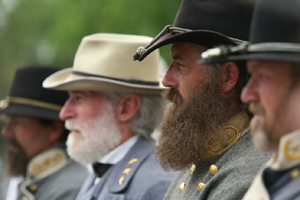
|
LEFT: General Robert E. Lee, aka Al Stone
- with Lieutenant General James Longstreet
(second from right) portrayed by Jay Vogel
- appears at a Lynchburg Civil War
re-enactment.
Photo: Todd
Hundley/Lynchburg Historical Society
|
LIVING THE CAUSE: Lee's
Lieutenants
by Michael Aubrecht, The Free
Lance-Star: TOWN & COUNTY Feature
Date published: 9/22/07 Section: CIVIL WAR
Also online at: Civil War re-enactment group
strives for the most realistic portrayals of key
Southern figures
The
dictionary defines a re-enactor as "a person who
re-creates a character in a historical event such
as a battle" or "a person who portrays history as a
pastime." This is true. Unfortunately, however,
these two definitions don't even begin to describe
the contribution to the preservation of American
history that re-enactors provide.
With reverence for their characters
beyond that of any actors preparing for the stage,
these men and women dedicate their lives to
educating the public while maintaining the
honorable memories of those whom they portray. In
essence, as "living historians" they themselves are
the attraction. Theirs is an expensive hobby, but
its benefits are priceless, because without them,
the stories of our nation's heroes would inevitably
be forgotten.
Without question, the most popular
re-enactments are those depicting the American
Civil War. Since their inception in the early
1900s, hundreds of re-enactor groups have been
chartered across the country, each portraying a
brigade or company. Some units are better than
others, but all of them strive to look and act the
part.
To
my knowledge, no other organization embodies its
characters better than Lee's Lieutenants.
Christened the "Headquarters Army of Northern
Virginia," this group was formed in 2003 to promote
and teach the history of the war for Southern
independence.
To
date, the group boasts ultra-realistic portrayals
of Gens. Robert E. Lee, James Longstreet, Thomas J.
"Stonewall" Jackson, J.E.B. Stuart, George Pickett,
Jubal Early, Lewis Armistead and others, including
several members of their staffs, along with
civilians. Some members have appeared in TV
documentaries, while others have been captured on
canvas posing for renowned Civil War painter Mort
Künstler.
Horses, spouses, troops and
children round out the group's complete cast. Most
impressive is the absence of any Hollywood
illusion. There are no fake beards or facial
prosthetics in this group. These generals look just
like the men they portray. In fact, they are so
uncanny that attendees at their events sometimes
feel as if they actually traveled back in time, if
only for a moment.
DEBATES, NOT BATTLES
Lee's Lieutenants participate in
many living-history events throughout the year, and
host one of the most original, called "The
Gathering of Eagles." Unlike traditional battle
re-enactments, this exhibition features a series of
public debates and question-and-answer sessions
designed to enlighten all who desire to learn the
causes and effects of the War Between the States.
This weekend-long affair, held at the Old
Courthouse Museum in Winchester, hosts the greatest
number of re-enactors portraying generals from both
armies of any event in the Mid-Atlantic
region.
To
understand what makes these individuals dedicate so
much of their time and talents to preserving and
presenting history, I asked several members
representing each branch of Lee's Lieutenants to
share their thoughts on what re-enacting means to
them. I queried Gen. Robert E. Lee, as portrayed by
Al Stone; then Maj. Gen. Isaac Ridgeway Trimble,
portrayed by his collateral descendant David C.
Trimble; then camp chaplain Alan Farley of the
Re-enactor's Missions for Jesus Christ; followed by
a displaced civilian schoolteacher portrayed by
Jessie Reter-Choate; and finally, Civil War
photography pioneer Mathew Brady, portrayed by
Wayne Ritchie.
Each member had a unique insight
into why re-enacting is so important to our region,
explaining to me the benefits for both historians
and their audiences.
|
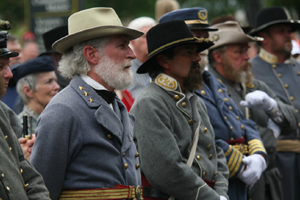
|
LEFT: General Robert E. Lee (Al Stone)
looks on with his officers at a Lynchburg
ceremony honoring Lieutenant General
Thomas J. 'Stonewall' Jackson.
Photo: Todd
Hundley/Lynchburg Historical Society
|
GEN. ROBERT E. LEE
It's not surprising that Al Stone
was among the busiest of these people, this year
being the 200th anniversary of Robert E. Lee's
birth. He had just returned from a number of
special appearances in the North, including a
special tour of the U.S. Military Academy at West
Point, where his namesake was both a student and,
later, the superintendent. After that, Stone was
off to Harrisonburg with his troops for its
400th-anniversary Jamestown celebration.
This hectic schedule is nothing
unusual for Lee's Lieutenants, whose members travel
to various re-enactments and appearances almost
every weekend during the spring and summer. Much
like the real Army of Northern Virginia, this group
does not stay put for very long. Thankfully, we now
live in the age of the Internet, which enabled this
reporter to conduct interviews far from the field.
The guys at Harper's Weekly never had it so
good.
'HISTORY ALIVE!'
I
first asked what led each member to his or her
interest in re-enacting. I was surprised at how
similar their answers were, even though the group
did not come together until many years after each
member got his or her start.
"About 17 years ago, I attended a
Civil War re-enactment with a friend and enjoyed
the experience so much that my wife and I began
attending others," Stone said. "Within the year, we
were dressing in 1860s-period civilian clothing and
spending most of our spare time traveling to such
events. It was a new experience--being a part of
history alive!"
He
described what led to his transformation into
Robert E. Lee:
"While attending re-enactments in
period civilian clothing, soldier re-enactors began
saluting me and others began recognizing me as Gen.
Robert E. Lee. My friend who introduced me to the
hobby explained that I resembled Gen. Lee and that
I should consider offering an impression of him.
Initially, I responded with an emphatic no.
However, after recognizing that others were doing
it, I changed my mind, and five years after
attending my first re-enactment, I began portraying
Gen. Lee. Now, after having studied the general, I
have expanded my studies into the constitutional
and economic issues surrounding the war."
|
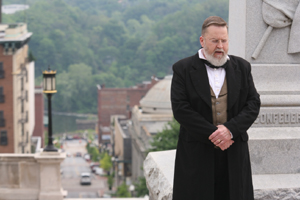
|
LEFT: Chaplain Alan Farley of the
Re-enactor's Missions for Jesus Christ
leads a prayer at the base of the
Confederate Monument in
Lynchburg.
Photo: Todd
Hundley/Lynchburg Historical Society
|
INTEREST REKINDLED
Alan Farley has a similar story,
but his journey has led him to use the re-enactor
platform for his own evangelical ministry. The
chaplain founded the Re-enactor's Missions for
Jesus Christ in the 1980s, and spends almost every
week of the year traveling with his family and
preaching the Gospel at historical sites all over
the country.
He
explained what led him to becoming a full-time
battlefield believer:
"Back in 1979, I rekindled an
interest in the War Between the States that I had
started back in the 1960s." He added: "The
ministry, on the other hand, came some five years
later, in 1984. It grew out of a frustration of
wanting to go to church on Sunday morning while at
a re-enactment and not being able to leave to find
a church. Plus, there was no one at that time
portraying a chaplain, nor holding a real church
service for the re-enactors. That is where I came
in."
SHARING THE LEGACY
Many participants in the hobby have
blood ancestors who served under the very flags
flown by their descendants today. Re-enacting is
their way of honoring their lineage and sharing the
legacies of their forefathers.
David Trimble is an example of one
member who discovered his roots.
"I
learned of the existence of Isaac Ridgeway Trimble
on a trip to Gettysburg. His name was on one of the
markers commemorating Pickett's Charge," he said.
"To a child, to see your last name on a marker was
pretty cool! Over the years, I learned that I was
in fact a collateral ancestor of the general. We're
from different brothers who came to America
together, so some form of cousin."
Trimble was so taken by this
discovery that he published a biography of his
namesake, "Furious, Insatiable Fighter: A Biography
of Maj. Gen. Isaac Ridgeway Trimble, C.S.A."
(University Press of America, 2005).
Not
all members are in uniform, though. Just as in
history itself, the civilian experience is equally
important. Lee's Lieutenants stands out among other
groups because its members make a concerted effort
to include everyday citizens and refugees in their
presentations.
|
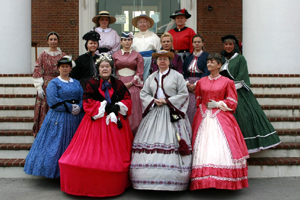
|
LEFT: A bevy of lovely ladies accompany
their Lee's Lieutenants husbands into the
field, portraying civilians, wives,
refugees and spies. Skilled in crafts,
many make their own costumes and camp
flags.
Photo: John C. Duke
|
EDUCATIONAL VALUE
Jessie Reter-Choate portrays a
schoolteacher, which isn't much of a stretch for
her, since it is her profession. She shared with me
the educational value of re-enacting:
"As
a teacher, I wanted to relate my hobby to modern
life. Obviously, I am interested in the history of
the development of education as well as the Civil
War period."
She
added: "The living-history angle allows for
involvement on the participant's part. Younger
visitors are also better engaged in living history.
It's what we're about--educate, enlighten and
entertain. The three E's!"
|
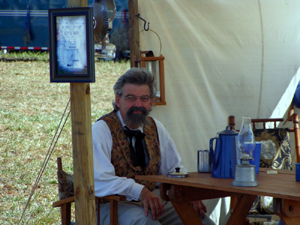
|
LEFT: Visitors to the Lee's Lieutenants
camp can meet photography pioneer Mathew
Brady, aka Wayne Ritchie, who travels with
a darkroom wagon, camera and field
accoutrements.
Photo: Lee's Lieutenants
|
PHOTOGRAPHIC PIONEER
One
of the most original and popular attractions at a
Lee's Lieutenants camp is a wagon containing a
complete field photography darkroom, managed by the
pioneer of wartime photography himself, Mathew
Brady.
Brady is portrayed by Wayne
Ritchie, who is one of the newest members to the
group. After taking photographs strictly as a
spectator at various events, Wayne was asked if he
would be interested in doing a period version.
He
explained to me the challenges that came with
portraying someone who is remembered for what he
accomplished behind the camera, not in front of
it.
"The hardest part was trying to
gain information on Mr. Brady, as there are only a
handful of books about him and even less pictures
to go by," he said. "The reason I enjoy this hobby
is the educating of the public on Mathew Brady and
his involvement with the Civil War. Taking on the
persona only adds to the realistic values of the
person you are portraying."
PERSONALLY REWARDING
All
five members said they have chosen a hobby that is
a double-edged sword of sorts: a labor of love,
though extremely expensive and time-consuming.
Re-enactors spend hundreds of
dollars on uniforms, hoop skirts, tents, fuel, food
and lodging. Cavalrymen, infantrymen and
artillerymen spend more money on horses, weapons
and powder. Still, the benefits for both the
portrayers and their audiences are worth the
financial commitments.
"Over the many years of study and
conversations with others, I have become familiar
with the issues of the contest that are not taught
nor normally discussed," Stone said. "Programs that
I offer bring out these issues, and it's most
gratifying when I see a person light up with
recognition. It's as if a light bulb just turned on
in a person's mind--a 'now they know the rest of
the story' type of thing. When that happens, I get
my greatest reward."
He
continued: "They, in turn, will now do their own
research and study and will be able to talk in a
more intelligent manner about the war. Oftentimes,
I will get mail from some of these folks as they
study--and that is even more rewarding."
This is a recurring theme on a
spiritual level, too.
"For me, living histories give us a
chance to talk to one person and lots of folks in
one setting. We are able to disseminate a lot of
material, a lot of facts that the average person
would not spend the time to look up on their own,"
Farley said.
"Besides being called to be a
missionary and share Christ, I also feel called to
present our nation's history from a Christian
perspective. Our founding fathers were dependent
upon God and led by God, and that is the story we
must get to the nation."
Trimble notes the importance of the
message behind the method.
"[Historian] Shelby Foote was
quoted as saying, 'If we do not understand the
American Civil War, there is no way we can
understand the America of today.' I think he was
100 percent correct. As I said before, it is far,
far better to study the truth of our common past,
and I mean the whole truth, good and bad, and to
embrace it, understand it and learn from it, than
it ever will be to paraphrase it in modern, PC
terms, launder it and then hide it from
sight."
Reter-Choate enjoys the opportunity
to share history with the thousands of visitors who
attend these events throughout the year.
Re-enactments should be educational as well as
entertaining, she said, and attendees should go
home with a better understanding of the War Between
the States than they had when they arrived.
Her
greatest personal reward is when a visitor
expresses gratitude and "tells you he/she really
enjoyed what you shared with him," Reter-Choate
said.
Most people don't realize that such
an experience is really a give-and-take proposition
in which re-enactors benefit just as much as their
audience.
Stone summed up what makes
portraying Lee and his subordinates so special for
the group's members:
"As
an individual passing along little-discussed facts
of the war, it is rewarding, but as a member of a
group such as Lee's Lieutenants, filled with people
who do the same thing, it is doubly rewarding," he
said. "It is our duty to teach the most accurate
history of our country that we can, lest we forget
and repeat it. We must not let the generations to
follow be ignorant of what our founding fathers
wanted for us."
Living historians fill an important
role in the education of our society. They provide
an honest look at some of the most important,
formative years of our country, when its very
existence hung in the balance.
These historical figures' story is
ultimately our story, and they are a piece of the
foundation of our existence today. Thanks to the
dedication of groups such as Lee's Lieutenants, the
service and sacrifice of those individuals will
never be forgotten.
For
more information, visit leeslieutenants.com and
rmjc.org.
SIDEBAR: MEET THE PEOPLE BEHIND THE
CHARACTERS
Al
Stone, born in New York, now resides in West
Virginia. He has portrayed Gen. Robert E. Lee for
more than 10 years. In 2004, Stone offered more
than 100 presentations to more than 60,000 people.
He has also appeared with such notables as artist
Mort Künstler and Virginia Tech historian
"Bud" Robertson.
Chaplain Alan Farley lives in
Concord, near Lynchburg. The founder and director
of the Re-enactor's Missions for Jesus Christ, he
has been on the re-enacting trail for more than two
decades. The Farley family travels more than 30,000
miles a year, conducting revivals and services at
Civil War re-enactments nationwide.
David C. Trimble, an attorney in
Lexington, Ky., who has been re-enacting since
2003, portrays his collateral ancestor, Maj. Gen.
Isaac Ridgeway Trimble. When not depicting Gen.
Trimble, he rides as a cavalry trooper in the 4th
Kentucky Cavalry.
Jessie Reter-Choate lives in
Spotsylvania County on a small ranch that rescues
horses and trains them for living-history events
and battles. Like her character, a "refugee
schoolteacher," she is a teacher. Reter-Choate
works at King George High School teaching English,
debate and journalism. She is also the school's
debate coach.
Wayne Ritchie lives in Rocky Mount,
N.C., and works for SE&M construction company.
He has been appearing and taking photographs as
Mathew Brady for four years now. Ritchie became
interested in Civil War re-enactments in 2000, and
began actively participating in 2001 after going to
more than a dozen events and places.
MICHAEL AUBRECHT is a local Civil
War author and historian whose latest book project
is on the area's historic churches. For more
information, visit his Web site at... Send e-mail
to his attention to gwoolf@freelance star.com.
|